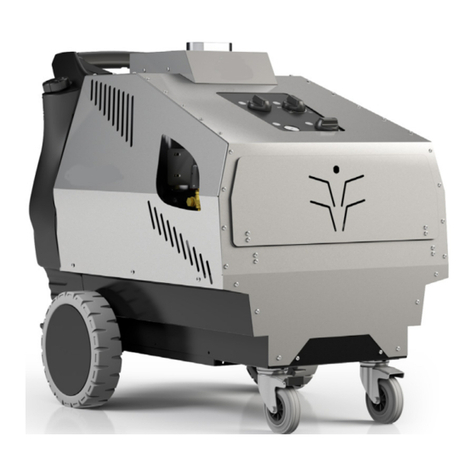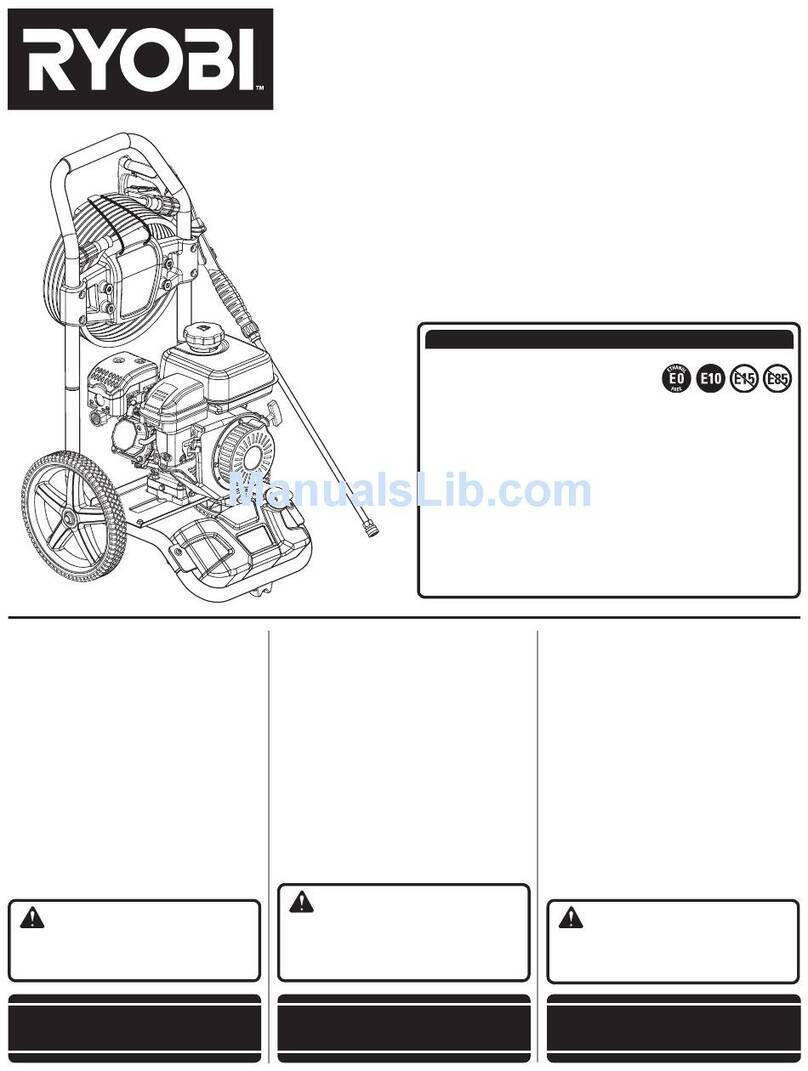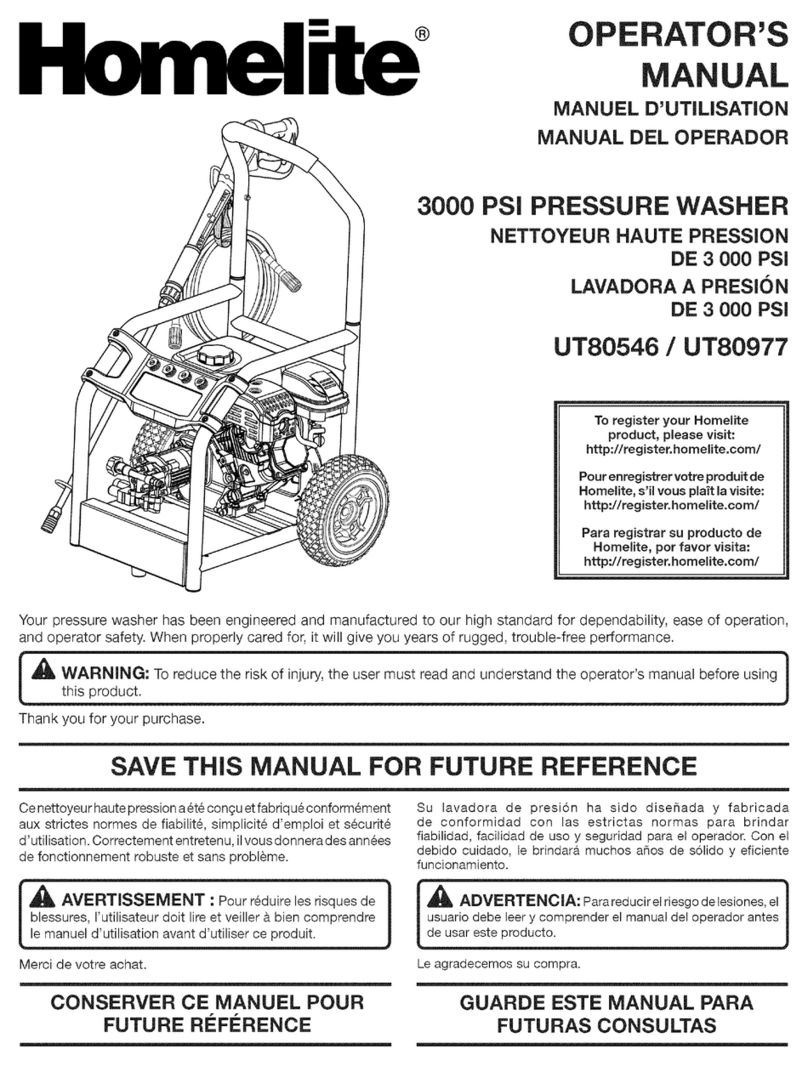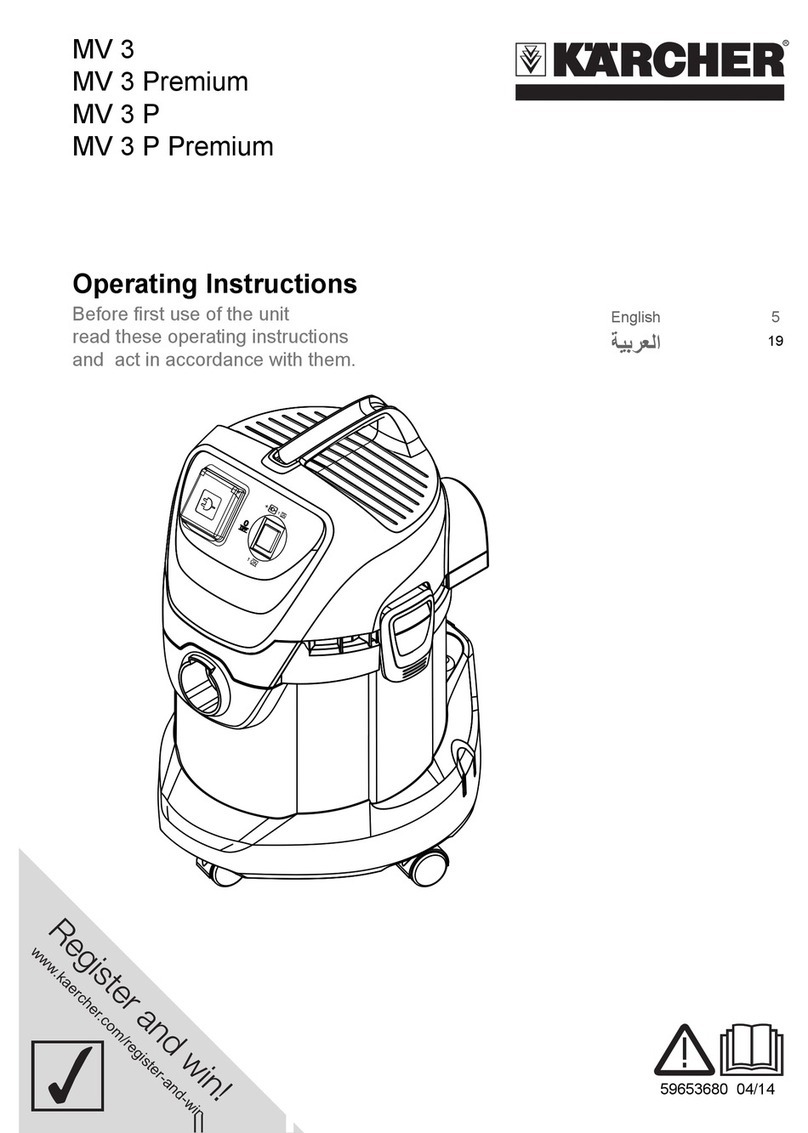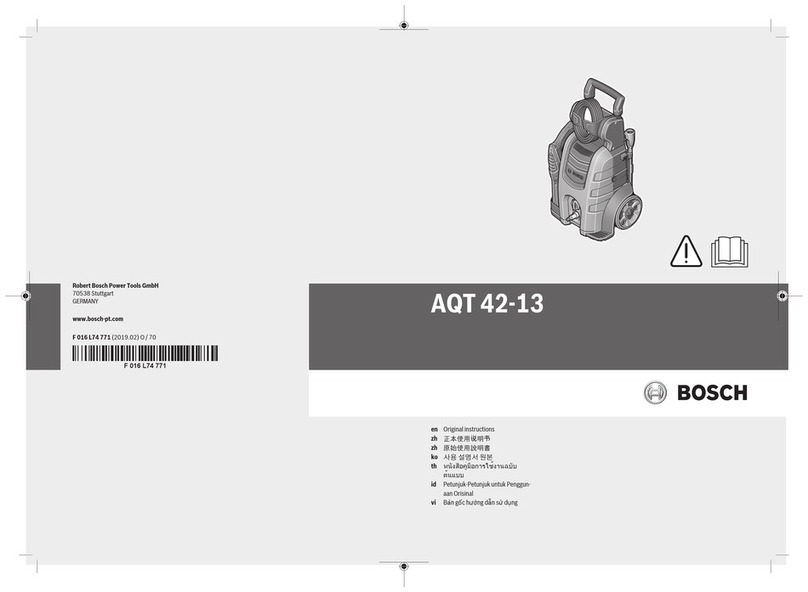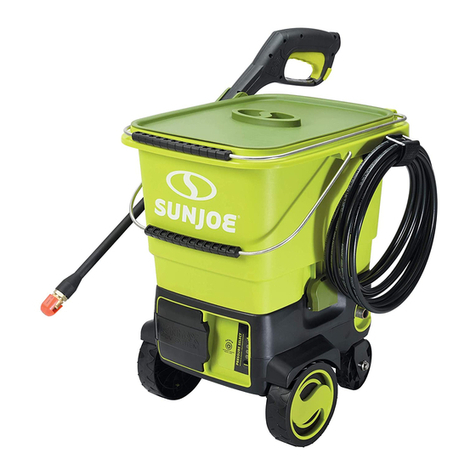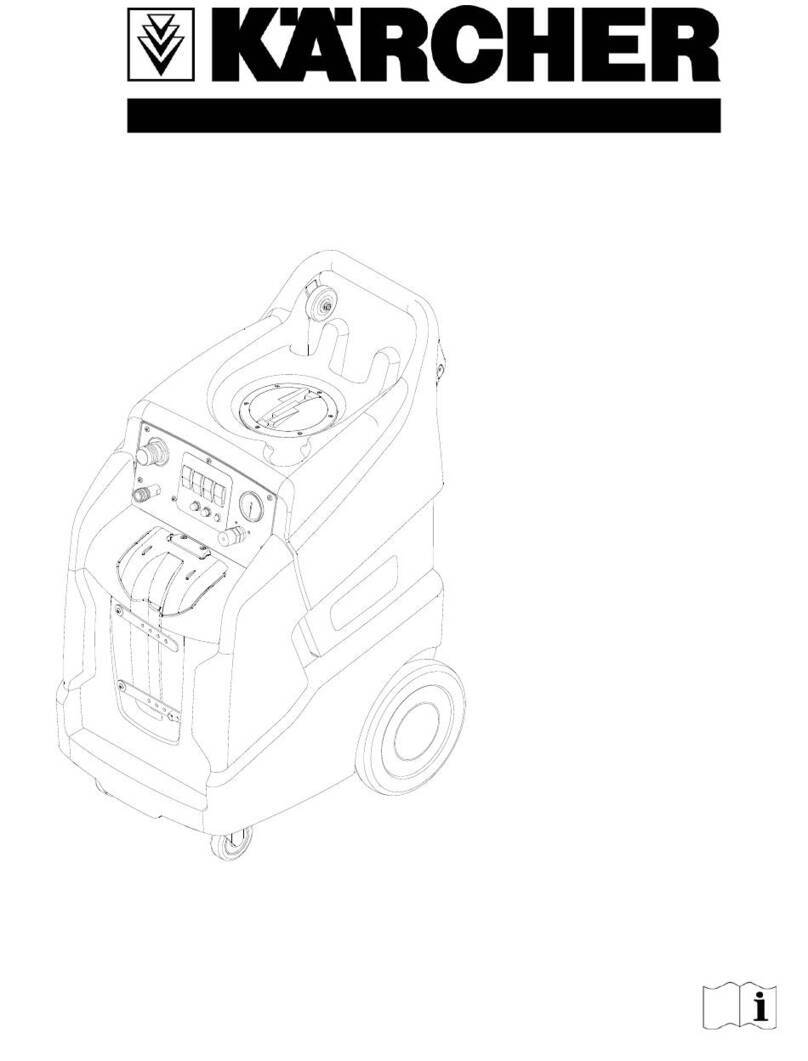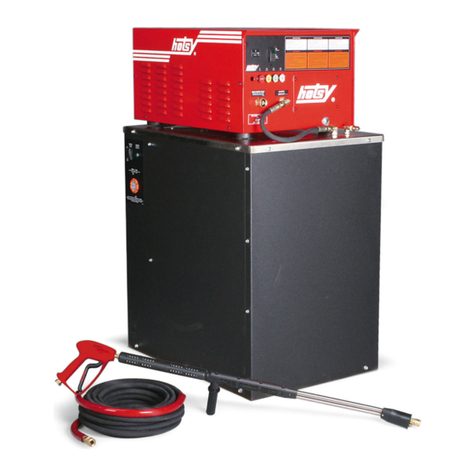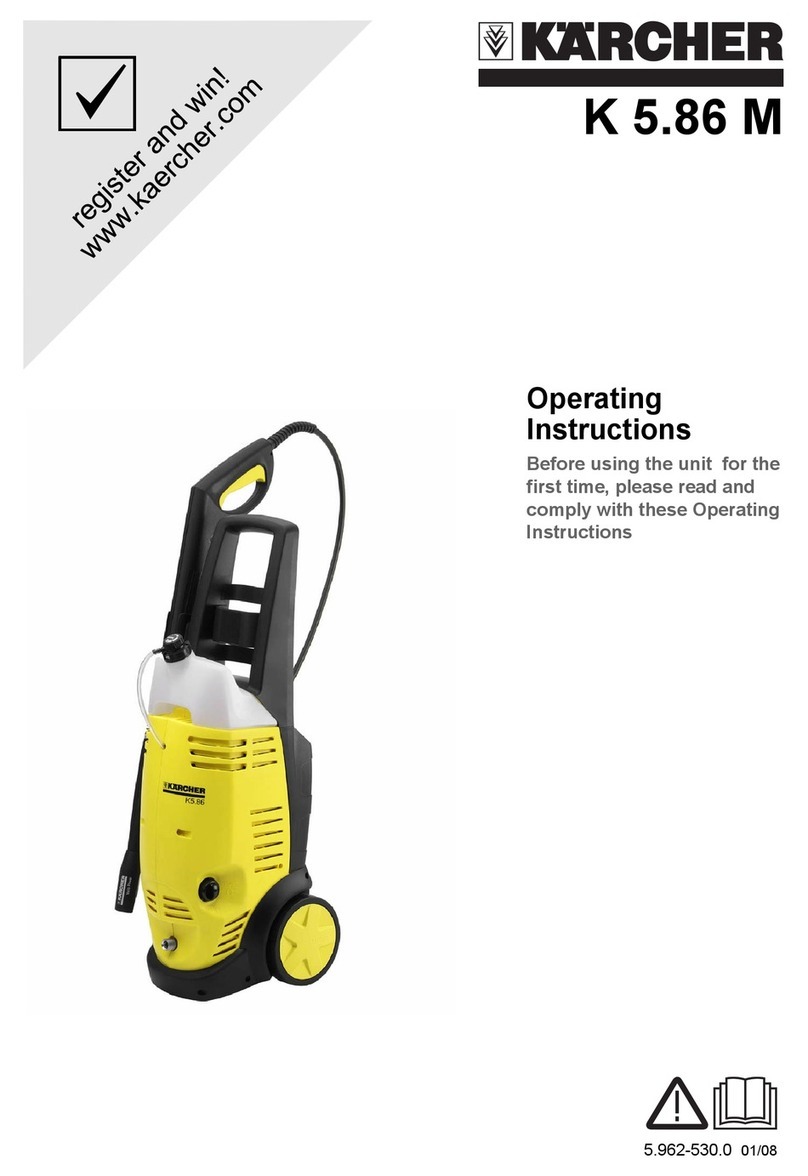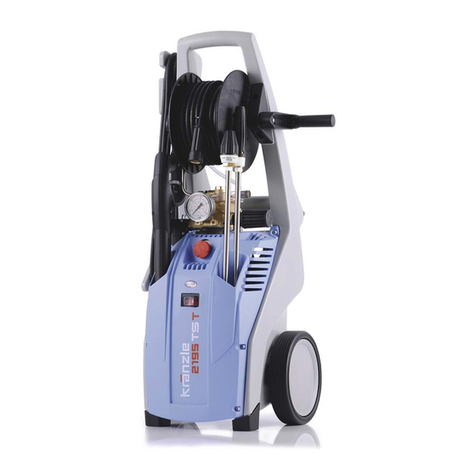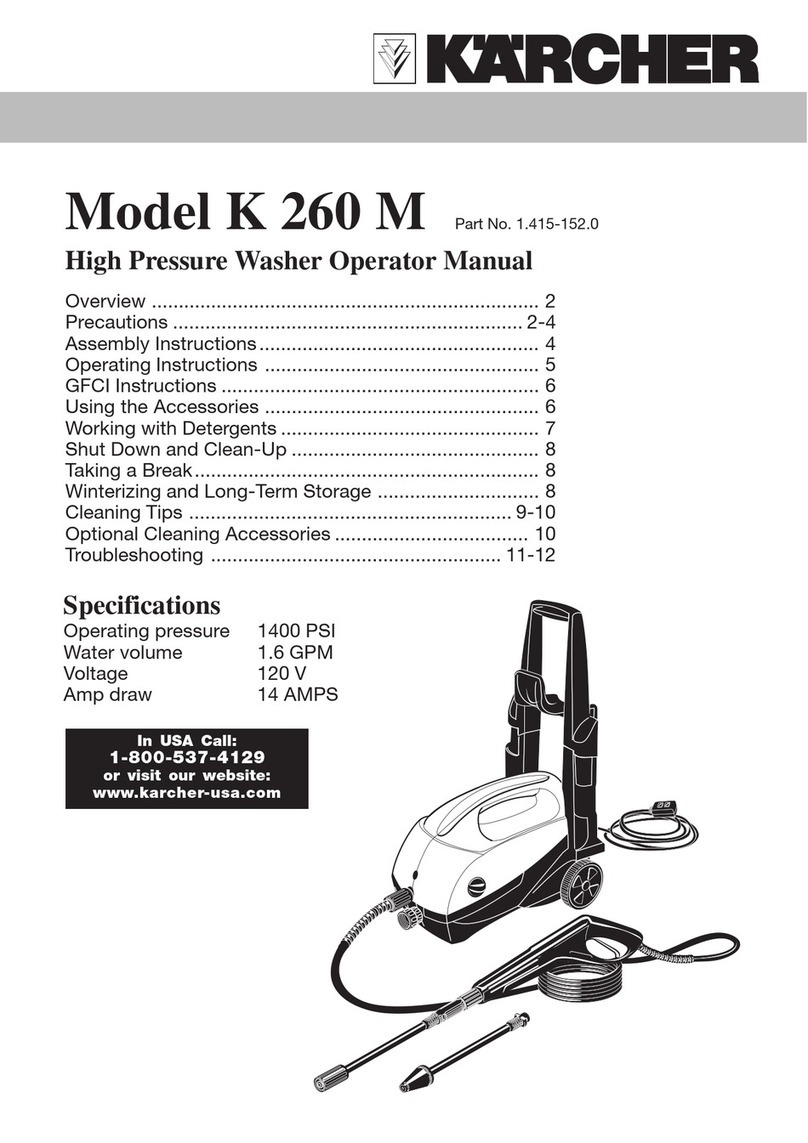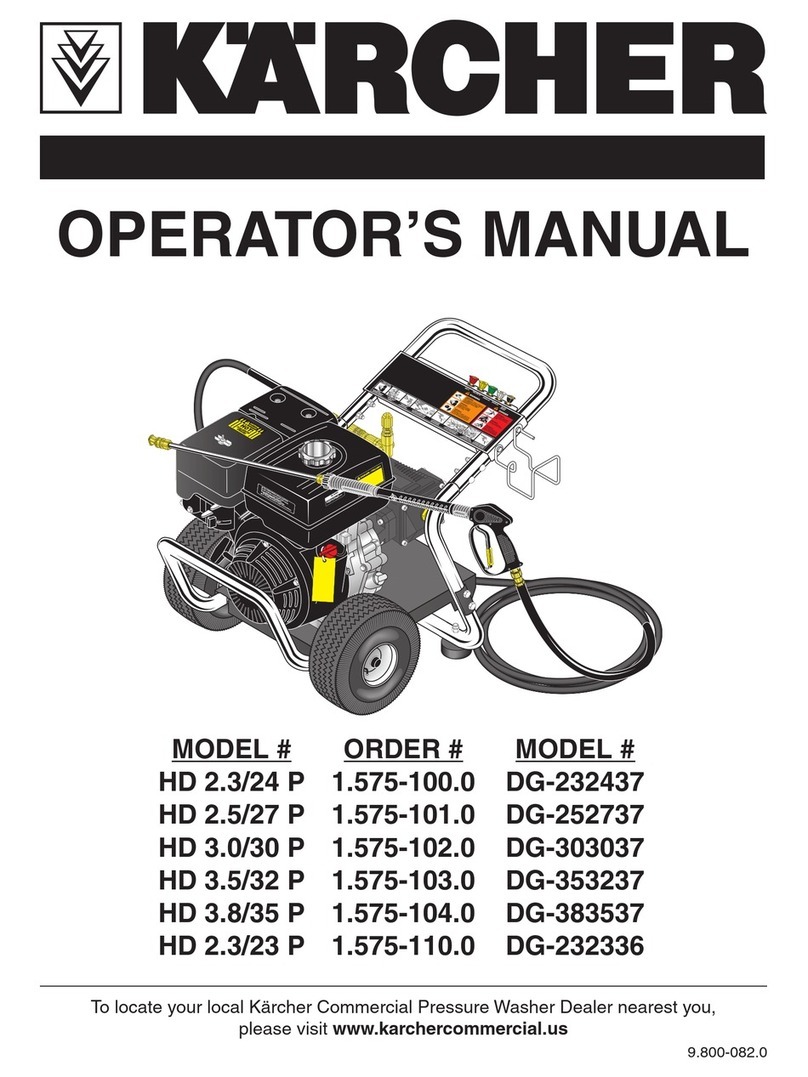CRAFTOP GHW2900A User manual

Owner’s Manual
High Pressure Washer
GHW2900A
EXPERTS
IN EQUIPMENTS OF
GARDENING AND AGRICULTURE
ENGLISH
VERSION: 01-202106

We thank you for buying CRAFTOP High Pressure Washer
This high pressure washer provides advanced technology in incorporating many convenient features for you to
perform your daily cleaning work.
Before attempting to use this high pressure washer, please read this manual carefully until you completely
understand and can follow all safety rules, precautions, operating and maintenance instructions. It will help
you both to become more familiar with this high pressure washer and to recognize and avoid situations that could
endanger you and others. Careless or improper use may cause serious or even fatal injury!
If you have any question about your high pressure washer and this manual, please contact your local authorized
dealer or service center. They always welcome your questions, suggestions, and constructive criticism.
We hope you enjoy this high pressure washer and wish you many years of safe and enjoyable cleaning work.
CRAFTOP CANADA LTD.

|-1-
Table of contents
Guide to use this manual .............................................1
Product overview..........................................................3
Technical specification .................................................7
Safety precautions and instructions .............................8
Assembly....................................................................14
Engine oil....................................................................16
Fuel and fueling..........................................................16
Detergent....................................................................17
Preparation................................................................. 18
Start and stop the engine ...........................................19
Operation....................................................................20
Working techniques....................................................21
Maintenance and care................................................22
Repair.........................................................................25
Storage....................................................................... 25
Disposal......................................................................26
Troubleshooting guide................................................28
Guide to use this manual
This User’s Manual refers to a CRAFTOP high pressure
washer, also called a machine in this User’s Manual.
All information, specifications, descriptions and
illustrations in this manual are as accurate as known at
the time of publication, but are subject to change
without notice. Due to ongoing product development,
there may be difference between your machine and the
information in this manual. No legal obligations or
commitments can be delivered from the information,
specifications, descriptions, or illustrations in this
manual.
Illustrations are only for orientation and are merely used
to help explain the text descriptions and instructions.
Illustrations may include optional equipment and
accessories, and may not include all standard
equipment.
Some signs or symbols on the machine may be a little
different refer to special certification requirements for
certain markets.
Any technical modifications to the machine that were
introduced after the editorial deadline please consult
your local dealer for more supplementary information.
All safety precautions and instructions described in this
manual should be observed during operation of the high
pressure washer, and all applicable federal, state and
local safety regulations, standards, and ordinances
should be observed as well.
Do not sell, lend or rent the machine without this user’s
manual. Always be sure to include this user’s manual
together with this machine, and make sure that anyone
using it understands the information contained in this
manual.
Signs and symbols in this manual
DANGER
Texts with this symbol contain information regarding
hazardous situations which will cause death or severe
injures if not avoided.
WARNING
Texts with this symbol contain information regarding
hazardous situations which could cause death or
severe injures if not avoided.
CAUTION
Texts with this symbol contain information regarding
hazardous situations which could cause minor or
moderate injures if not avoided.
NOTICE
Texts with this symbol information regarding situation
which could cause high pressure washer damage if not
avoided.
information
Texts with this symbol contain supplementary
information.
Waning or Alert!
Special safety precautions must be
observed when working with this
machine because it has high speed
rotation parts, uses flammable fuel,
produces high pressure water, and
exhausts poisonous fumes.
Read and understand the User’s
Manual.
Read this User’s Manual carefully,
make sure that you completely
understand and can follow all safety
rules, precautions, operating and
maintenance instructions before
attempting to use this high pressure
washer, failure to do so may cause
serious or even fatal injury!
Wear proper clothing.
Eye and ear protection required.
Always wear appropriate safety
goggles or safety glasses with side
shields, and ear plugs or ear
mufflers as well when operating this
machine.
Hair protection required.
Operator who has long hair should
tie up and confine long hair with a
hair net, cap, or hard hat for
instance.

|-2-
Respiratory protection required.
Wear proper respiratory protection
to protect you from chemical
solvents, aerosols, oils, mold, and
other more harmful airborne
particles or allergens that may go
unseen.
Hands protection.
Always wear appropriate gloves
when you handle chemical
detergent or operate high pressure
washer.
Foot protection required.
Wear shoes or boots with anti-slip
soles in your working area.
Fire hazard.
Risk of fire.
Flammable material or their fumes
may catch fire easily if near heat,
flames or sparks.
No smoking.
Do not smoke in this area.
Toxic Fumes.
Chemicals contained in the engine
exhausts can cause cancer and
birth defects and other reproductive
harm.
Poisonous.
The skull and crossbones symbol
means the product is poisonous or
has/produce poisonous material.
Licking, eating, drinking, or smelling
a substance marked with this
symbol can make you very sick or
even cause death.
Risk of Asphyxiation.
This engine exhausts carbon
monoxide, an odorless, colorless
poison gas. Breathing carbon
monoxide can cause nausea,
fainting or even death. Only use this
machine in a well ventilated outside
area.
Hazards of electric shock.
Be careful of high voltage cable
when you use machine.
Do not touch!
Warning of hot surface.
Contact may cause burn.
Do not touch!
Risk of injections.
To reduce the risk of injection or
injury, never direct a water stream
towards people or pets or place any
body part in the stream. Leaking
hoses and fittings are also capable
of causing injection injury. Do not
hold hoses or fittings.
Risk of Explosion.
Do not spray flammable liquids.
Flammable liquids, fuel, and their
vapors are explosive and can cause
severe burns or death.
Risk of kickback.
To reduce the risk of injury from
kickback, hold the gun and wand
securely with both hands when
work with the machine.
Signs and symbols on the machine
For the purpose of safety operation and maintenance,
the meanings of signs and symbols may be attached to
or embossed on the machine.
The port to top up fuel.
Position: Fuel cap
The port to top up engine oil.
Position: Oil cap
Choke control.
Choke closed.
“Cold start” position.
Choke control.
Choke open.
“Run” position.

|-3-
Product overview

|-4-

|-5-
Index Part Name Description
1 Handle It is used to maneuver the machine when transporting by hands.
2 Trigger Locking Latch It is used to prevent from accidental operation or spraying accidentally.
3 Spray Trigger Squeeze it to spray pressure water out; and, release it to stop.
4 Spray gun holster Used to place the spray gun on the machine when not in use.
5 Spray Gun It is used to handle and spray water under pressure.
6 Muffler Ensure you avoid contact as this will be hot during and shortly after use.
Avoid resting the pressure hose on muffler.
7 Air Filter Air filter should be replaced annually to ensure optimal engine
performance.
8 Spray Wand It is used to extend your reach for easier cleaning.
9 Wheel Provides easy mobility for the machine to move manually on the ground.
10 Support shoe To support the machine together with wheels when it is in use or during
storage.

|-6-
Index Part Name Description
11 Recoil Starter This is used to start the engine.
12 Recoil Starter Rope
Handle It is used to pull the starter rope.
13 Fuel Tank 3.8L capacity.
14 Fuel Cap Ensure fuel cap is tightened securely during operation.
15 Fuel Valve Regulates the flow of fuel to the engine. Must be fully open before starting
the engine.
16 Choke Lever It is used to control incoming air.
17 Throttle Lever This is used to adjust the engine speed.
18 Engine Switch On/Off Switch, ensure this is turned to ‘ON’ position before attempting to
start the engine.
19 Detergent Tank Cap Take this cap off to fill detergent tank with approved detergent.
20 Detergent Tank A tank designed for approved detergent.
21 Oil drain plug Remove it and allow used oil to drain out.
22 Oil Dipstick Ensure the machine has the proper level of oil before starting engine. Only
use SAE 10W-30 oil.
23 Pump Inlet Using included quick-connect coupling, attach your garden hose here.
24 Thermal Relief Valve This includes a drain pipe to be used if resting water inside pump becomes
too hot. This will help prevent overheat damage to pump.
25 Spray Nozzles 0°, 15°, 25°, 40°, soap tip; Use to apply the right pressure and stream
pattern for each specific application.
26 Pump outlet Attach your pressure hose here.
27 Detergent hose Connect between detergent tank and pump.
28
Carburetor fuel drain
plug
Remove it and allow fuel in the carburetor to drain out.
29 Carburetor A device in an internal combustion engine for mixing air with a fine spray of
liquid fuel.
30 Spark Plug Should be checked every 100 hours of operation.
31 Pressure Hose hook To hang the pressure hose when not in use.
32 Pressure Hose Attach to pump and gun.
This machine is designed for specific residential applications. Do not modify or use for any application other than
which it is designed. This equipment is not designed for industrial use. Please refer to the icons below for suggested
applications.
Stairs Car Fencing Deck and Patio
Garage floor Driveway Sidings Painting preparation

|-7-
Technical specification
MODEL GHW2900A
Item Description Unit Specification
Overall
Product dimension (L x W x H) in(mm) 30x20x41(760x495x1045)
Net weight lbs(kg) 73(33)
Maximum water flow rate GPM 2.3
Application temperature ︒C 5~50
Engine
Type 4 stroke gasoline engine
Displacement cc 196
Power (OHV) HP 6.5
Starter Recoil starter
Spark Plug Gap in(mm) 0.028~0.031(0.7~0.8)
Pump
Type
Heavy-duty maintenance-free
axial cam
Maximum water pressure PSI 3000
Rated water pressure PSI 2300
Minimum inlet pressure PSI 30
Maximum inlet pressure PSI 60
Maximum temperature of pumped
fluid ︒C 40
High pressure hose
Inner diameter in(mm) 1/4(6.2)
Length ft(m) 20(6)
Inlet & Discharge Ports
Type Standard garden hose connector
Size inch 3/4
Spray Nozzles
Type 0°, 15°, 25°, 40°, soap tip
Quantity Total 5
Detergent tank Tank capacity L 3
Fuel
Type Unleaded gasoline
Tank capacity L 3.8
Engine oil
Type SAE 10W-30
Tank capacity L 0.6
Wheels
Type Plastic wheels
Size in(mm) 11(280)
Standard features
This pressure washer is equipped with the following safety features:
-Thermal Relief Valve
Protects the pump from overheating in case nozzle becomes clogged. This system
should not be abused. Make every effort to prevent the pump from overheating.
-Low-Oil Auto Shut-Off
This pressure washer is equipped with a low oil shut-off system. If the engine oil level
goes below the recommended oil level, the pressure washer will automatically
shut-off. This protects your engine and prevents operating without proper lubrication.

|-8-
information
Specifications, descriptions and illustrations in this manual are as accurate as known at the time of publication, but are
subject to change without notice.
Safety precautions and instructions
Special safety precautions must be
observed when working with this
machine because it has high speed
rotation parts, uses flammable fuel,
produces high pressure water, and
exhausts poisonous fumes.
Before attempting to use this high
pressure washer, please read this
manual carefully until you completely
understand and can follow all safety
rules, precautions, operating and
maintenance instructions. Careless or
improper use may cause serious or
even fatal injury!
Safety precautions
DANGER
•
Because a high pressure washer has high speed
rotation parts, uses flammable fuel, produces high
pressure water, and exhausts poisonous fumes,
some special precautions must be observed to
reduce the risk of accident and personal injury.
Careless or improper use may cause serious or even
fatal injury.
•
Rotating parts can entangle hair, hands, clothing, feet
and/or accessories. Traumatic amputation or severe
laceration can result.
•
Gasoline is an extremely flammable fuel. If spilled
and ignited by a spark or other ignition source, it can
cause fire and serious burn injury or property damage.
Use extreme caution when handling gasoline.
Combustible fuel vapor may escape from the fuel
system or container during fueling operations. Do not
smoke or bring any fire or flame near the fuel or the
machine.
•
Never point the spray nozzle at a person, an animal
or yourself. Keep clear of nozzle. Always wear proper
clothing and PPE(Personal Protective Equipments)
when operating or performing maintenance.
•
All electrical conductors and communications wires
can have electricity flow with high voltages. This
machine is not insulated against electrical current.
Never spay the water steam to wires, otherwise
serious injury or even death may result.
•
DO not direct high pressure stream at persons,
animals, electrical devices, or the machine itself. High
pressure jets can be dangerous if subject to misuse,
and result in high risk of injection or injury.
•
Do not operate this machine indoors or in
inadequately ventilated areas. DO not allow exhaust
fumes to enter a confined area through windows,
doors, vents or other openings. Engine exhaust
contains poisonous emissions and can cause serious
injury or death.
WARNING
•
Observe all applicable local safety regulations,
standards and ordinances.
•
Never spray flammable liquids or use pressure
washer in areas containing combustible dust, liquids,
or vapor.
•
To prevent accidental water spray, always place the
spray trigger in the locked position and engage the
trigger locking latch when not in use.
•
Running engines produce heat. Severe burns can
occur on contact. Combustible material can catch fire
on contact.
•
The noise emitted from this machine may be
restricted to certain times by national or local
regulations.
•
Use of pressure washers can create wet walking
surfaces. While using a pressure washer, forces from
the gun can cause you to loose footing and fall.
•
Minors should never be allowed to use this high
pressure washer. Do not allow other persons near the
high pressure washer when starting or operating.
Keep bystanders, especially children, and animals
out of the work area and keep a safe distance. Close
supervision of children is necessary to ensure that
they do not enter the work area or play with the
machine.
•
Never let your pressure washer run unattended.
When it is not in use (e.g., during a work break), shut
it off and make sure that unauthorized persons do not
use it.
•
The person who use this high pressure washer must
be in good physical condition and mental health, and
not under the influence of alcohol and drugs. Never
use this high pressure washer when you are fatigued,
sick, or upset. If you feel tired, take a break.
•
The components of this machine generate an
electromagnetic field during operation, which may
interfere with some pacemakers. To reduce the risk of
serious or fatal injury, persons with pacemakers
should consult with their physician and the
pacemaker manufacturer before operating this
machine. In the absence of such information,
CRAFTOP does not recommend the use of this
machine by anyone who has a pacemaker.
•
The user of this machine is responsible for avoiding
injury to third parties or damage to their property.
CAUTION
Prolonged exposure to cold and/or vibration may result
in injury. Read and follow all safety and operation
instructions to minimize risk of injury. Failure to follow
instructions may result in painful wrist/hand/arm
injuries.
Raynaud’s Phenomenon may affect the fingers of
certain individual if a person is exposed to vibration and
cold. Exposure to vibration and cold may cause tingling

|-9-
and burning sensations, followed by loss of color and
numbness in the fingers. The following precautions are
strongly recommended:
•
Keep your body warm, especially the head, neck,
hands, wrists, ankles and feet, ,.
•
Maintain good blood circulation by performing
vigorous arm exercises during frequent work breaks.
•
Limit the hours of operation, have a rest when you
feel tired or fatigued.
•
If you experience discomfort, redness, and swelling of
the fingers followed by whitening and loss of feeling,
consult your physician before continuing exposing
yourself to cold and vibration.
Overusing the muscles and tendons of the fingers,
hands, arms, and shoulders may cause soreness,
swelling, numbness, weakness, and extreme pain in
those areas.
•
Avoid using your wrist in a bent, extended, or twisted
posture. Instead, try to maintain a straight wrist
position. Also, when grasping, use your whole hand,
not just the thumb and index finger.
•
Take periodic breaks to minimize repetition and let
your hands have a rest.
•
Reduce the speed and force with which you do the
repetitive movement.
•
Do exercise to strengthen your hands and arm
muscles.
•
Immediately stop using the machine and other power
tools, and consult a doctor if you feel tingling,
numbness, or pain in the fingers, hands, wrists, or
arms.
Clothing and PPE
WARNING
You must wear proper clothing and approved personal
protective equipments (PPE) whenever you use a high
pressure washer.
Eye and ear protection required.
Always wear appropriate safety
goggles or safety glasses with side
shields, and ear plugs or ear
mufflers as well when operating this
machine.
Respiratory protection required.
Wear proper respiratory protection
to protect you from chemical
solvents, aerosols, oils, mold, and
other more harmful airborne
particles or allergens that may go
unseen.
Hair protection required.
Operator who has long hair should
tie up tie up and confine long hair
with a hair net, cap, or hard hat for
instance.
Hands protection.
Always wear appropriate gloves
when you handle chemical
detergent or operate high pressure
washer.
Proper clothing.
Clothing must be snug-fitting but
allow complete freedom of your
movements.
Do not wear loose clothing, jewelry,
scarf, necktie, or anything that could
get caught in moving pats of the
machine.
Foot protection.
Wear shoes or boots with anti-slip
soles in your working area.
Personal protective equipments can not eliminate the
risk of injury, but it will reduce the degree of injury if an
accident does happen. Ask your high pressure washer
dealer for help in choosing the right equipments.
Long-time or continuous exposure to high noise levels
may cause permanent hearing impairment. Always
wear approved hearing protection when operating a
high pressure washer.
Handle your high pressure washer safely
WARNING
This pressure washer is to be used only by qualified
operators. Minors and untrained persons should never
be allowed to use this machine.
This high pressure washer must only be used to clean
solid surfaces and other items that will not be damaged
by high pressure water or the force of the spray jet. Do
not use it for other purposes, since misuse may result in
personal injury or property damage, including damage
to the machine. Before using this machine to perform
your work, always practice on a inconspicuous test area
to understand when damage may occur.
Under any circumstance, you should not modify the
original design of the high pressure washer without
approval from the manufacturer. Always use genuine
spare parts. Unauthorized modifications or accessories
may lead to serious or even fatal injury.
Under any circumstance, you should not operate your
high pressure washer if it is damaged, improperly
adjusted or maintained, or not completely or securely
assembled. Always inspect the high pressure washer
before each use, and replace the parts immediately if it
is worn, loose, leaking, damaged or missing.
•
Never point the spray nozzle at persons, animals,
electrical devices, plants or the machine itself.
•
Do not let water in the pump, hose and other parts of
the machine freeze.
•
Do not run the machine dry. Be sure the water supply
is completely turned on before operating the
machine.

|-10-
•
Only use cold water.
•
Always disconnect spark plug wire and place wire
where it can not contact spark plug to prevent
accidental starting when setting up, transporting,
adjusting or making repairs except carburetor
adjustments.
•
Always hold the spray attachment firmly with two
hands when performing your cleaning work. The
spray jet causes reactive forces on the spray
attachment in a direction opposite to the direction of
the spray (recoil or kickback). Hold the spray
attachment firmly with both hands in order to control
the reactive forces, including any additional torque
produced when using angled spray attachments or an
angled spray wand.
•
Do not operate a high pressure washer with one hand.
Serious injury to the operator, helpers, bystanders or
any combination of these persons may result from
one-handed operation. The high pressure washer
MUST be used with two hands!
•
Always engage the trigger safety latch in the safe
position when spraying is stopped even if only for a
few moments.
•
Never put hand or fingers over the spray tip while
operating the machine.
•
Operate the high pressure washer only in a
well-ventilated outdoor area. Never start or run the
engine inside a closed room or building. Exhaust
fumes contain dangerous carbon monoxide.
•
Never operate the machine at night, at times of heavy
fog, or at any other times when your field of vision
might be limited and it would be difficult to maintain a
clear view of the working area.
•
During rain, storms at times of strong or gale-force
winds, or at any other times when weather conditions
might make it unsafe to use this machine.
•
Do not allow any material to block the cooling slots.
•
Carefully plan your cleaning operation in advance.
Never start cleaning until you have a clear work area.
•
Maintain footing and balance at all times. Do not
stand on slippery, uneven or unstable surfaces. Do
not operate the high pressure washer in odd position
or on a ladder or ladders.
•
Keep exhaust area clear of flammable debris. Avoid
contact hot surfaces during and immediately after
operation.
•
Do not use a pressure washer to clean pressure
washer. The solid jet of high pressure water may
damage parts of the machine.
Maintain in good work order
CAUTION
All high pressure washer service, other than the items
listed in the maintenance section of this manual, should
be performed by authorized service dealer or
competent high pressure washer service personnel.
WARNING
Only use high-quality replacement parts in order to
avoid the risk of accidents and damage to the power
tool. If you have any questions in this respect, consult
an authorized dealer or service center. CRAFTOP
recommends the use of genuine spare parts. They are
specifically designed to match your model and meet
your performance requirements.
•
To reduce the risk of injury, always shut off the engine
before carrying out any maintenance or repairs or
cleaning the machine, only excepts carburetor and
idle speed adjustments.
•
Check the machine for loose/missing nuts, bolts, and
screws. Tighten and/or replace as needed.
•
Do not turn the engine over on the starter with the
spark plug boot or spark plug removed since there is
otherwise a risk of fire from uncontained sparking.
•
Check fuel system for leaks due to fuel tank damage,
especially if the machine is dropped accidently. If
damages or leaks are found, do not use the machine
any more, otherwise serious personal injury or
property damage may occur. Have your machine
repaired by an authorized dealer or service center
before using.
•
Check the fuel filler cap for leaks at regular intervals.
•
Check the engine oil level is located at the proper
position.
•
To reduce the risk of fire, do not service or store your
machine near open flames.
•
Use only a spark plug type which is approved by
CRAFTOP and make sure it is in good condition.
•
Inspect the ignition lead (insulation in good condition,
secure connection).
•
Check the condition of the muffler. To reduce the risk
of fire and damage to hearing, do not operate your
machine if the muffler is damaged or missing.
•
Do not touch a the muffler, spark plug, or other
metallic parts of the engine while the engine is
running or immediately shutting down, otherwise burn
injury will result.
Transporting your high pressure washer
Avoid accidental starting. Transport or move the
machine only with empty fuel tank. Be sure the engine
switch is off before transporting the machine.

|-11-
When transporting your high pressure washer in a
vehicle, properly secure the machine to avoid turnover,
fuel spillage and damage.
Handle fuel with caution
You high pressure washer use a unleaded gasoline for
fuel.
WARNING
Gasoline is an extremely flammable fuel. Pay high
attention when fueling, storing or handling, otherwise
serious personal injury may result.
If spilled and ignited by a spark or
other ignition source, gasoline can
cause fire and serious burn injury or
property damage.
Do not smoke or bring any fire or
flame while handling fuel or while
operating the high pressure washer.
Note that combustible fuel vapor
may escape from the fuel system.
•
Fuel used in this pressure washer is poisonous.
Always wear approved breathing protection when
decanting fuel.
•
Handle fuel and refuel in a well ventilated outdoor
area on bare ground; store fuel in a cool, dry well
ventilated place; and use an approved, marked
container for all fuel purposes. Wipe up all fuel spills
before starting the machine.
•
Eliminate all sources of sparks or flame(i.e. smoking,
open flames, or work that can cause sparks) in the
areas where fuel is mixed, poured, or stored. Always
shut off the engine and allow it to cool down before
refueling.
•
Always use with caution when handling fuel. Wipe up
all spills and then move the high pressure washer at
least 10feet (3 meters) from the fueling point before
starling the engine.
•
Always shut off the engine before refueling, let the
machine cool in a non-combustible area, not on dry
leaves, straw, paper, etc. Do not fuel a hot engine –
fuel may spill and cause a fire.
•
Loose a bit of the fuel cap carefully so as to allow any
pressure build-up in the fuel tank to release slowly
and avoid fuel spillage.. Never remove the fuel cap
when engine is running!
•
Fuel your machine only in well ventilated areas. If you
spill fuel, wipe the machine immediately. If fuel spills
on your clothing, change it immediately.
•
Tight the fuel cap securely to the proper position,
make sure it does not loosen or come off due to the
machine vibrations.
•
To reduce the risk of serious or fatal burn injuries,
check for fuel leakage. If fuel leakage is found, do not
start or run the engine until leak is fixed.
•
Do not inhale fuel fumes as they are toxic.
•
Store the machine and fuel in an area where fuel
vapors cannot reach sparks or open flames from
water heaters, electric motors or switches, furnaces,
etc.
Connect to water supply
Do not connect the pressure washer directly to a
potable water system.
If hooking up the pressure washer to a potable water
system, a backflow preventer must be installed
between the water tap and the hose. The design of the
backflow preventer must comply with the applicable
country-specific regulations.
If potable water has passed through the backflow
preventer, it can no longer be regarded as potable
water.
Follow the rules and guidelines issued by the local
water supply company to prevent water flowing back
from the pressure washer into the drinking water
system.
Do not use the machine with dirty water (i.e., water that
contains sand, dirt or other particulate matter). If there
is a risk that the water supply is dirty, find and use an
alternative water source.
Before starting the engine
A area within a minimum radius of 50feet (15m) from
the using the machine should be considered as a
hazardous area, into which on one should enter. If
necessary, yellow warning rope and warning signs
should be placed around the perimeter of the area.
When work is to be performed simultaneously by two or
more persons, special care should also be taken to
constantly look around or otherwise check for the
presence and locations of other people working, so as
to maintain sufficient safety distance between each
person.
Before starting the engine, check that your machine is
properly assembled and in good condition:
•
The machine may only be used when all parts are in
proper working order. Never operate your pressure
washer if it is modified, damaged, improperly adjusted
or maintained, or not completely or securely
assembled. Never run the pressure washer with a
modified or disconnected governor. Never attempt to
modify the controls or safety devices in any way.
•
Check the fuel system for leaks, paying high attention
to visible parts such as the fuel tank cap, hose
connections and the manual fuel pump (if equipped).
If there are any leaks or other sign of damage, do not
start the engine because of potential risk. Have your
machine repaired by an authorized dealer or service
center before using it again.
•
Always use the high-pressure hose in good condition
and not frayed, cracked, deformed or damaged in any
way. Never operate the machine with a damaged or
worn high-pressure hose, otherwise replace it before
further use. Using a worn or damaged hose, or one
that does not meet the high pressure requirements of
the pressure washer, can result in personal injury.
•
Inspect the spray wand and spray gun for damage
before starting work. The spray trigger on the spray
gun must move easily and automatically return to its
starting position when released. The trigger locking
latch must be in proper working condition. Keep the
gripping surfaces clean at all times; free of pitch, oil,
fuel, grease or resin in order for you to maintain a firm
grip and properly control your pressure washer.

|-12-
•
Check that the spark plug boot is securely mounted
on the spark plug. If a loose boot may cause arcing
which could ignite combustible fumes and cause a
fire.
•
Check the engine switch, choke lever, throttle lever,
and trigger locking latch for proper function. The
throttle lever must move freely.
•
Keep all handles dry and clean, free from oil and dirt
– for safe control of the machine.
•
Always connect and turn on the water supply to the
pump before starting the engine. Do not operate the
pressure washer without water. Running the pressure
washer without water will cause the pump overheated,
which may result in permanent damage.
When starting the engine
WARNING
Your pressure washer is designed to be operated by
one person only. Do not allow other persons in the work
area even when starting.
•
Do not operate this pressure washer in temperatures
below 5°C. Operating pressure washer under the
temperature of 5°C may cause damage to pump and
other pressure washer parts. Damage to pressure
washer by user misuse is not covered under
warranty.
•
To reduce the risk of eye or other injury from water
spray and blown or sprayed objects, You must wear
proper clothing and approved personal protective
equipments (PPE) when you start the engine and
operate the machine.
•
Start the engine at least 10feet (3m) from the fueling
point, at a well-ventilated area, outdoors only.
•
Keep bystanders, especially children and animals at
least 50feet (15m) from the operating point. If you are
approached, immediately stop the engine and
engage the trigger locking latch on the spray gun.
•
Place the machine on firm ground in an open and well
ventilated area. Make sure you have good balance
and secure footing.
•
When you pull the starter rope handle, do not wrap
the starter rope around your hand. Do not allow the
rope to snap back by itself, but guide the starter rope
slowly back to permit the rope to rewind properly.
Failure to follow this procedure may result in injuries
to your hand or fingers and may damage the starter
mechanism.
information
When a new machine is first operated, in the first few
minutes grease may come out of the gear case. But,
since this is excessive grease, there is no cause of
alarm. Just wipe it off with the engine stopped for next
use
During operation
WARNING
Moving parts can amputate fingers or cause severe
injuries. Keep hands, clothing and loose objects away
from all moving parts. Always stop engine, disconnect
spark plug, and make sure all moving parts have come
to a complete stop before removing obstructions,
clearing debris, or servicing unit.
To reduce the risk of fire resulting in
serious or fatal injury or property
damage, never spray flammable or
combustible liquids.
To reduce the risk of explosion
resulting in serious or fatal injury or
property damage, never spray
flammable or combustible liquids.
To reduce the risk of short
circuiting, fire and electrocution,
never direct the spray at electrical
appliances and equipment, sockets
or power cords.
Keep hands and feet and other
parts of your body away from the
water jet at all times. Severe
laceration and fluid injection could
result from contact with the water
jet. Because of the high pressure
and spray velocity, fluids can
penetrate the skin and cause fluid
injection and/or severe cutting
injury. If an accident does occur and
the spray appears to have
penetrated the skin, seek
emergency medical care. Do not
treat as a simple cut.
Risk of Explosion.
Do not spray flammable liquids.
Flammable liquids, fuel, and their
vapors are explosive and can cause
severe burns or death.
Risk of kickback.
To reduce the risk of injury from
kickback, hold the gun and wand
securely with both hands when
work with the machine.
STOP
In the event of impending danger or
in an emergency, switch off the
engine immediately by pressing the
engine stop switch backward to
STOP position, and engage the
trigger locking latch.
•
Always hold the spray attachment firmly with both
hands in order to control the reactive forces, including
any additional torque produced when using angled
spray attachments or an angled spray wand. The
spray jet causes reactive forces on the spray
attachment in a direction opposite to the direction of
the spray (recoil or kickback).
•
Never direct the high pressure jet toward yourself or
other persons, not even to clean clothing or shoes.
Do not direct the high pressure jet toward animals.

|-13-
•
Do not overreach. Keep proper footing and balance at
all times. Special care must be taken in slippery
conditions and when working on slopes or uneven
ground.
•
To reduce the risk of stumbling and loss of control, do
not walk backward while operating the pressure
washer.
•
To reduce the risk of injury from loss of control, never
operate the pressure washer while standing on a
ladder or on any other unstable support.
•
Always carry related tools, equipments, spare parts,
and consumables with you:
-
Attached tools in the product package.
-
Personal protective equipments.
-
Properly reserved fuel
-
Spare parts (spare blade, etc.).
-
Things to notify your working are (rope, warning
signs, etc.).
-
Whistle (for collaboration or emergency).
•
Check that there are no bystanders, children, and
animals in the general work area. If someone comes:
-
Guard against hazardous situations at all times.
Warn adults to keep children and pets away from
your working area. Be careful if you are approached.
Injury may result from high pressure sprays.
-
If someone calls out or otherwise interrupts you
while working, always be sure to shut off the
spray gun and the engine before turning around.
Avoid operating which people, especially children
are nearby.
•
Always be aware of surroundings and stay alert for
possible hazards that you may not hear due to the
noise of the machine.
•
Make sure you always have good balance and secure
footing. Place your feet slightly apart (slightly further
apart than the width of your shoulders), so that your
weight is distributed evenly across both legs, and
always be sure to maintain a steady, even posture
while working.
•
Take special care in slippery conditions (wet ground),
on slopes or uneven ground.
•
Watch out for obstacles (hose, plants, bricks, etc.)
which could cause you to trip or stumble.
•
Do not direct the high-pressure jet into places you
cannot see. Watch the spray direction at all times, be
extremely careful when cleaning tall obstacles(large
vehicle, building, etc.), check the other side of the
obstacle before starting work.
•
Never draw fluids into the pump that contain solvents
or undiluted acids (e.g., gasoline, heating oil, paint
thinner or acetone). These substances damage the
materials used in the machine. The spray is highly
combustible, explosive and poisonous.
•
Be particularly alert and cautious when wearing
hearing protection because your ability to hear
warnings (shouts, alarms, etc.) is restricted.
•
To reduce the risk of accidents, take sufficient break
in good time to avoid tiredness or exhaustion.
•
Work calmly and carefully in daylight conditions and
only when visibility is good. Stay alert so as not to
endanger others.
•
To reduce the risk of serious or fatal injury from
breathing toxic fumes, ensure proper ventilation when
working in trenches, hollows or other confined
locations.
•
To reduce the risk of accidents, stop work
immediately in the event of nausea, headache, visual
disturbances (e.g. reduced field of vision), problems
with hearing, dizziness, deterioration in ability to
concentrate. Apart from other possibilities, these
symptoms may be caused by an excessively high
concentration of exhaust gases in the work area.
•
Operate your machine so that it produces a minimum
of noise and emissions. Do not run the engine
unnecessarily, accelerate the engine only when
working. To avoid noise complaints, in general
operate the machine between 8AM and 5PM on
weekdays, and 9AM to 5PM on weekends, detail
please refer to your local regulations.
•
Do not operate your machine in the starting throttle
position because engine speed cannot be controlled
in this position.
•
To reduce the risk of fire, do not smoke while
operating or standing near your machine. Note that
combustible fuel vapor may escape from the fuel
system. Always clean plant residue, chips, debris,
leaves and excess lubricant off the engine and
muffler. Note that stop the engine before you perform
the cleaning work.
•
Check the fuel system in particular for leaks and
make sure the safety devices are working properly.
Do not continue operating your machine if it is
damaged. In case of doubt, consult your local
authorized deal or service center.
•
The muffler and other parts of the engine (gear box,
fins of the cylinder, spark plug) become hot during
operation and remain hot for a while after stopping
the engine. To reduce risk of burns, do not touch the
muffler and other parts while they are hot. Keep the
area around the muffler clean. Do not allow the high
pressure hose to make contact with the muffler.
•
Before leaving the machine unattended: Shut off the
engine.
After finishing your work
•
Shut off the engine after finishing work. Then turn off
the water supply and squeeze the spray gun trigger to
release trapped pressure. Engage the trigger locking
latch when not in use.
•
Disconnect the water intake hose between the
machine and water supply.
•
After the engine cool down, wipe away water with dry
cloth, always clean dust and dirt off the machine. Do
not use any grease solvents for this purpose.
•
Do not use a pressure washer to clean pressure
washer. The solid jet of high pressure water may
damage parts of the machine.

|-14-
Assembly
Your pressure washer requires some assembly. This
machine ships from our factory without engine oil. It
must be properly serviced with fuel and oil before
operation. If you have any questions regarding the
assembly of your pressure washer, please contact local
authorized dealer or service center.
Proper PPE are required when you unpack the box and
perform the assembly work.
You may need adjustable wrench, screw driver,
unleaded gasoline, engine oil, standard garden hose,
etc.
Parts included in the package
A standard high pressure washer package contains the
items as illustrated/listed below:
1. Frame, Qty.=1
2. Handle, Qty.=1
3. Wheel, Qty.=2
4. Spray gun, Qty.=1; Spray wand, Qty.=1
5. Axle, Qty.=2; Nut(M8), Qty.=2; Washer(Ø8), Qty.=2
6. Pressure hose, Qty.=1
7. Gun holster, Qty.=1
8. Hose hook, Qty.=1
9. Other items not shown:
-
Owner’s Manual, Qty.=1set.
-
Fasteners(Bolt, Nut, Washer), Qty.=1 set.
-
Spray nozzle cleaner, Qty.=1.
-
Spark plug wrench, Qty.=1
-
Replacement O-ring, Qty.=1set (2 for pressure
hose & 1 for quick connector).

|-15-
Unpack pressure washer
1. Set the shipping carton on a solid, flat surface.
2. Remove bubble wrap and other packaging
materials.
3. Remove all parts from the box except the pressure
washer.
4. Carefully cut each corner of the box from top to
bottom.
Wheels installation
1. Place the lower main frame on a solid, flat surface.
2. Lift the main frame with one hand.
3. Press the spring pin and insert wheel axle into the
tube on the main frame until the pin aligns with the
fixation hole and snap in.
4. Install wheel onto axle with washer and nut, tight
the nut securely, then put on the wheel cover.
5. Repeat this procedure to install another wheel.
Handle assembly
1. Align two posts of upper handle with the lower
frame.
2. Slide the upper handle downward into the tubes on
lower frame until the fixation holes match together.
3. Insert the screws, and tighten it securely with
washer and nut.
Gun holster assembly
1. Fix the gun holster onto the upper frame with bolt,
washer and nut; tight the nut securely.
2. Align the mounting hole on gun holster with the
fixation hole on upper frame.
3. Insert the screws, and tighten it securely with
washer and nut. Make sure the gun holster
installation direction is correct.
Hose hook assembly
1. Align the hose hook with the profile on the back of
the panel.
2. Slide it downward until it reaches the bottom place.
Gun and wand assembly
1. Pull back the rubber piece to expose the threaded
fitting.
2. Attach the spray wand to the trigger gun.
3. Screw the trigger gun clockwise until the spray
wand is secure. DO NOT OVER-TIGHTEN.
4. Move the rubber piece back.
Attach pressure hose to spray gun
1. Align one end connector of pressure hose with the
connector on spray gun.
2. Rotate plastic nut clockwise to attach pressure
hose to spray gun. Tighten the plastic nut securely.
DO NOT OVER-TIGHTEN.

|-16-
Engine oil
NOTICE
New pressure washer has no engine oil in crankcase
when they are delivered out of factory.
Do not attempt to crank or start the engine before it has
been properly filled with the recommended type and
amount of engine oil, otherwise damage to the pressure
washer may result.
Always check the engine oil level before starting the
engine, on a level surface.
NOTICE
The recommended engine oil type is SAE 10W-30, oil
crankcase capacity is 0.6L.
Add engine oil
1. Place the pressure washer on a flat level surface.
2. Clean the oil gauge dipstick/cap and the area
around it to ensure that no dirt falls into the
crankcase.
3. Turn the oil gauge dipstick/cap counterclockwise,
remove it and clean it with a clean cloth.
4. Add engine oil into the crankcase through the oil
gauge dipstick/cap installation port (a fuel funnel
may be needed here). Do not overfill.
5. Fully reinsert the oil gauge dipstick and pull it out to
check the oil level.
MAX
MIN
6. If the oil level is just at MIN marker or below, refill
SAE 10W-30 oil through the dipstick hole until the
oil level is between MIN and MAX marker.
7. Reposition the oil gauge dipstick and tighten it by
turning clockwise.
Fuel and fueling
NOTICE
New pressure washer has no engine oil in crankcase
when they are delivered out of factory.
Do not attempt to crank or start the engine before it has
been properly filled with the recommended type and
amount of engine oil, otherwise damage to the pressure
washer may result.
Always check the engine oil level before starting the
engine, on a level surface.
Fuel
WARNING
Gasoline is very flammable. Avoid smoking or bringing
any flame or sparks near fuel. Make sure to stop the
engine and allow it cool down before refueling the
machine. Select outdoor bare ground for fueling and
move at least 3 m (10 ft) away from the fuming point
before starting the engine.
The recommended fuel type is regular unleaded
gasoline with a minimum octane rating of 87 and an
ethanol content of less than 10% by volume, fuel tank
capacity is 3.8L.
This is a 4-cycle engine and does not require a gas/oil
mixture. There is a separate reservoir for gas and a
separate reservoir for oil.
NOTICE
Do not use mixed oil with gasoline for this machine
•
Exhaust emission are controlled by the fundamental
engine parameters and components (for example,
carburetion, ignition timing and port timing) without
addition of any major hardware or the introduction of
an inert material during combustion.
•
If you use a gasoline of a Iower octane value than
prescribed, there is a danger that the engine
temperature may rise and an engine problem such as
piston seizing may consequently occur.
•
Unleaded gasoline is recommended to reduce the
contamination of the air for the sake of your health
and the environment.
•
Poor quality gasoline or oil may damage sealing rings,
fuel lines or fuel tank of the engine.

|-17-
•
Take care when handling gasoline. Avoid direct
contact with the skin and avoid inhaling fuel vapor.
Fueling
1. Before fueling, clean the filler cap and the area
around it to ensure that no dirt falls into the fuel
tank.
2. Turn the fuel cap by turning it counterclockwise,
loose a bit of the fuel cap carefully so as to allow
any pressure build-up in the fuel tank to release
slowly. Never remove the fuel cap when engine is
running!
3. Use clean, fresh, regular unleaded fuel with a
minimum octane rating of 87 and an ethanol
content of less than 10% by volume.
4. Slowly add fuel to the tank. Do not overfill. Fuel can
be forced out of the tank as a result of expansion if
it is overfilled, and can affect the stable running
condition of the machine. When filling the tank, it is
recommended to leave enough space for the fuel to
expand. A minimum of 13mm (0.5inch) of space
below the bottom of the filler neck to provide space
for expansion.
5. Tighten the fuel cap clockwise securely after
fuelling.
6. Wipe away any spilled fuel.
Detergent
NOTICE
This pressure washer is intended for use with special
pressure washer detergents only. Follow the detergent
manufacturer’s directions, only use recommended
detergents for pressure washers. Using detergents not
specifically recommended for use with pressure
washers can cause damage to pump and other
pressure washer components. Damage caused to
pressure washer by using non-recommended detergent
is not covered under warranty.
NOTICE
Do not use powdered soaps which clog the injection
system.
NOTICE
Working with a detergent ensures quick soaking of the
dirt, and allows the high-pressure water to penetrate
and remove the dirt more effectively. Always spray
detergent on a dry surface, do not presoak the area.
Soaking the surface dilutes the detergent and reduces
its cleaning ability.
Some cleaning jobs can be completed by using only
water, but for most, it is advantageous to use a
detergent to penetrate and remove the dirt more
effectively. When using pressure washer approved
detergent, make sure the surface is clean and dry.
Wetting the surface first is not recommended; it will
dilute the detergent and will reduce the cleaning
effectiveness.
Add detergent
1. If need, add the detergent to a separate container
and dilute it with water at the ratio specified by the
detergent manufacturer. Do not dilute it in the
pressure washer detergent tank.
2. Turn the detergent tank cap counterclockwise to
open the cap.
3. Add detergent into the tank. Do not overfill. If
necessary, a funnel is recommended to use here.
This pressure washer is intended for use with
pressure washer detergents only.
Detergent
4. Turn the detergent tank cap clockwise to tighten the
detergent cap securely.
5. Wipe away any spilled detergent.
NOTICE
When finished with detergent, squeeze spray trigger
and continue cleaning with clean cold water, this can
help flush some detergent residue in the machine and
accessories.

|-18-
Cleaning with detergents
•
When using detergent, always use the black
detergent nozzle.
•
When applying detergents, always operate the
machine at a low water pressure. This provides a
gentle application of the detergent, with the water
pressure equivalent to a garden hose. Always test the
detergent in a concealed area before use.
•
The liquid detergent will be mixed with water
automatically, and discharged through the detergent
nozzle at a low pressure.
•
Avoid to spray water onto the cleaning surface when
it is hot surfaces or under direct sunlight, this will
minimize the chances of the detergent damaging the
painted surface.
•
Do not let the detergent dry or it may damage the
painted surface. Allow the detergent to remain on the
surface for a short time before rinsing with clean
water under high pressure.
Preparation
NOTICE
Always check the level of the engine oil prior to starting
the machine. Failure to do so could cause the engine to
seize if the oil is low or empty.
Pre-operation checklist
Follow the steps below before using the machine every
time:
1. Check the pressure washer location.
NOTICE
This pressure washer must have at least 1.5 m (5 ft.) of
clearance from combustible material. Leave at least 90
cm (3 ft.) of clearance on all sides of the pressure
washer to allow for adequate cooling, maintenance and
servicing. Place the pressure washer in a well
ventilated area. Do not place the pressure washer near
vents or intakes where exhaust fumes could be drawn
into occupied or confined spaces. Carefully consider
wind and air currents when positioning pressure
washer.
2. Check the engine oil level to make sure it is located
at the proper position.
3. Add fuel and check the fuel level to make sure there
is sufficient gasoline in the fuel tank.
4. Select appropriate spray nozzle and make sure it is
installed on the end of spray wand securely.
5. Securely connect high pressure hose to the pump
outlet, and connect the other end to the spray gun.
6. Securely connect the garden hose to the pump inlet,
and turn water on. The water supply must provide a
minimum of 4GPM at 30PSI, otherwise the pump
may be damaged.
7. Check/add the detergent in the detergent tank.
8. Water must be turned on prior to starting the
washer, pull the spray trigger to ensure water is
moving the through the lines and out the nozzle
without any leaks before starting the machine.
9. Check there is no leakage of oil, fuel, or water.
10. Double-check and observe all safety precautions
and instructions in this manual prior to starting the
machine.
Install spray nozzle
WARNING
Before removing, installing or adjusting any spray
nozzle or accessory, make sure to shut off the pressure
washer, relieve system pressure, and engage the spray
trigger locking latch, otherwise severe injury may result.
The end of spray wand has a quick connect coupler,
which allows you to connect, change, disconnect the
spray nozzle easily.
1. Shut off the pressure washer and squeeze the
spray trigger to relieve system pressure.
2. Engage the spray trigger locking latch.
3. Select appropriate spray nozzle for your cleaning
work.
4. Remove all sands and debris from nozzle and
coupler.
5. Pull the coupler collar (1) backward as far as it will
go and hold it there.
1
2
6. Push the spray nozzle (2) as far as it will go into the
coupler.
7. Push the coupling sleeve forward as far as it will go.
8. Pull the spray nozzle and confirm that it is seated in
the coupler securely.
WARNING
Confirm that the spray nozzle is fixed securely in quick
connect coupler on one end of spray wand. If the high
pressure nozzle is not securely fixed, it can shoot out of
the spray wand during operation and cause injury.
Connect the pressure hose to pump
1. Align one end threaded fitting on the hose with the
outlet on pump. Assume another end threaded
fitting on the hose has already been connected with
the spray gun.
2. Fully insert/match the threaded fitting with the
outlet.
3. Turn the plastic nut on the hose clockwise to tighten
the hose securely to the pump.
Table of contents

